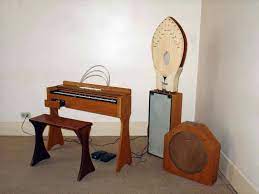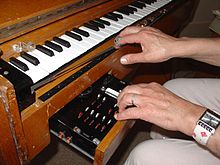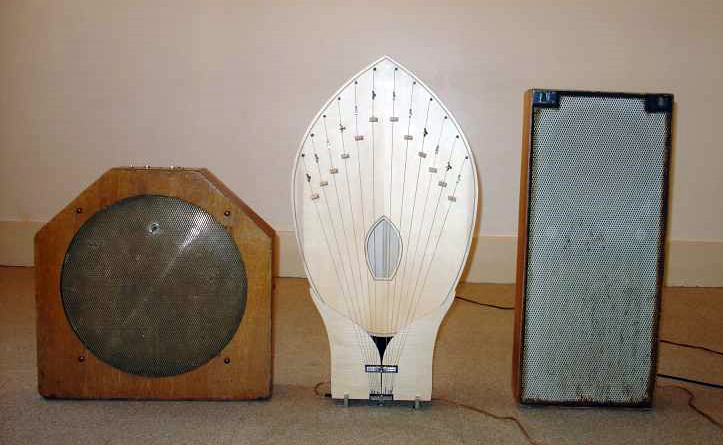At the beginning of the XX century many electronic instruments have been invented, some have had better luck than others, and one of these unlucky ones is the Ondes Martenot.
This instrument was invented in 1928 by Maurice Martenot, a French cellist.

But what is it? It is somewhat of a cross between an Organ and a Theremin.
Originally, the main interface was a metal ring, which the player worn in the right index finger. The movement of the finger (up and down a wire) creates a theremin-like tone. Then a four-octave keyboard was added, yet not a normal one, because it has moveable keys that create a vibrato when wiggled. All this is enclosed in a wooden frame that features a drawer that allows manipulation of volume and timbre by the left hand. Volume is controlled with a touch-sensitive glass “lozenge”, called the “gradation key”; the further the lozenge is depressed, the louder the volume.
Early models produce only a few waveforms. Later models can simultaneously generate sine, peak-limited triangle, square, pulse, and full-wave rectified sine waves, in addition to pink noise, all controlled by switches in the drawer.

The inventor was fascinated by the accidental overlapping of tones of military radio oscillators and wanted to build an instrument to replicate it, but with the same tonal expression as a cello.
Four speakers were produced for the instrument, called “diffuseurs”.
The “Métallique” (imm. below, first from left) features a gong instead of a speaker cone, producing a metallic timbre.
The “Palme” speaker (imm. below, middle), has a resonance chamber laced with strings tuned to all 12 semitones of an octave; when a note is played in tune, it resonates a particular string, producing chiming tones
The last one is a normal cabinet.

It has been used by composers such as Edgar Varèse, Pierre Boulez and Olivier Messiaen, but its “rebirth” in the modern era and its diffusion in the context of popular music can be attributed to Jonny Greenwood, best known for his role as a guitarist in Radiohead .
Jonny, visionary musician and creator of a new way of thinking and playing music, was so fascinated by the Ondes Martenot that he decided to integrate them into Radiohead’s music. This “journey” began with their amazing album Kid A (2000) and has been played on some of their most important songs ever since. In live performances of their song Weird Fishes/Arpeggi they even use a group of six ondes martenot.
Here is a collection of Radiohead’s songs with Ondes Martenot
Greenwood also wrote Smear, a piece for two Ondes Martenot:
Thanks to Jonny Greenwood it has had a new light and has found many applications in modern popular music. For example, Yann Tiersen used it for the Amelie soundtrack and Thomas Bloch, Ondes Martenot virtuoso, also played it on records by Tom Waits, Marianne Faithfull and in Damon Albarn’s Monkey: Journey to the West Opera.
References
[1] Wikipedia – Ondes Martenot.
[2] The Guardian – Hey, what’s that sound: Ondes martenot.
[3] Britannica – Ondes martenot.